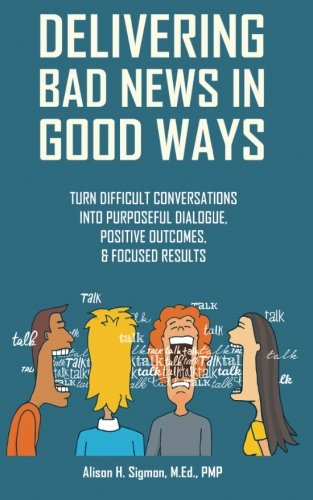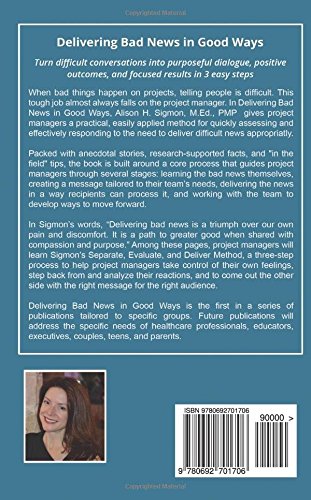


Delivering Bad News in Good Ways: Turn difficult conversations into purposeful dialogue, positive outcomes, & focused results in 3 easy steps
V**F
Great Contribution
I have spent over four decades thinking and writing about ways people in group and organizations can communicate, resolve conflict, problem solve, make decisions, and work together more effectively. In my judgment Allison Sigmon’s new book Delivering Bad News in Good Ways is an important contribution to this field, and I like it a lot.After providing a straightforward definition of effective communications, as an “exchange of information among individuals and groups”… “delivered in a good and timely manner, ” Ms. Sigmon describes the difficulties we all have in providing negative feedback and delivering bad news. She then proceeds to describe several practical steps we can take to help this unfortunate situation.Several aspects of Delivering Bad News in Good Ways stand out. The anecdotal stories used to begin each chapter are cleaver and realistic. They portray the problems faced by individuals in real life situations and provide a backdrop for providing valuable tips and advice. The advice provided goes beyond common sense and is laced with more than a smattering of science drawing from psychology and social psychology, and includes well respected references to sources like David Brooks’ The Social Animal and several contemporary researchers in the neurosciences. Her descriptions about how the human mind works and the effects of emotion on human interaction in social situations are particularly strong as is her three step process: Separate, Evaluate, and Deliver (SED) for achieving clear communication and problem solving in difficult situations.The examples provided, though excellent, are sometimes a bit difficult to follow. In the main, however, the writing style is clear and straightforward making the book easy to read and understand. If a second edition of the book is under consideration, I recommend that the “chapter takeaways” feature be expanded to provide more thorough chapter reviews and that the checklists that appear throughout the book be judiciously trimmed.
E**.
I never thought about how delivering bad news can actually be a good thing
Imagine how your life could change if you were suddenly able to deliver verbal “tough love” with grace and tact? All those situations where the proverbial “white elephant” no longer keeps you locked into inaction. In my life I’ve found it very difficult to do this, and yet, with the refined and tested SED method, I’m confident I have a much more effective toolset to work with. First, I never thought about how delivering bad news can actually be a good thing, and in the best interest of others, in order to bring out better ends. It’s easy to fall prey to the “lure of magical thinking” and allow fear to keep us in a state of perpetual denial. Second, she goes into a very thorough explanation of how the mind works, and how to harness it to diffuse our internal fears, pivot to a more rational frame of mind, and architect a far more effective path of communication. Third, she offers deep insight into the various decision-making styles of audience, so you can tailor your message in the most palatable way for them. It’s not easy, and there is no “silver bullet” because every audience and situation is a little different. However, the book does something that surprised me….it equips you with everything you need to handle this from an inside-out perspective. The journey starts with us, and our minds, and the more we can navigate this mentally in advance, and prepare ourselves for many of the probable scenarios, the more our fear dissolves and we actually enjoy being agents of change.
T**.
Good information in a helpful format
The book has some very useful tips and I like how the author goes about using examples to help explain things.
T**N
This is a great read!
Not only does this book show you how to deliver bad news in good ways, but it shows you how your own psyche can alter the way you see your environment and how each day is molded by our responses to said news.The sections are split in odd ways and to really grasp this book, I recommend reading this book in as short of a time period as possible. If you space it out, there will be references from previous scenarios that might take a moment to recollect. Overall, this is a great read and I recommend it to those in Management positions or those that must deliver bad news on a regular basis.
M**.
Text on Kindle version too light to read comfortably
The text of this book on the Kindle version is too light to read comfortably. I'm using an e-ink Kindle so you may not have a problem if you're reading it on a Kindle Fire or the Kindle app. I found the text lightness way too annoying. I had to use Calibre to edit the CSS stylesheet to darken it. (Instructions by Google search: Faded text in one specific book : kindle - Reddit)I haven't read much of the book yet, only the intro, but I'll update my review (removing stars) if necessary.
J**I
Very complex
This is my first Alison Sigmon book. I found her writing style a bit difficult to follow. Long complex examples include several work related issues, The examples were then used as references to her web sight . . At the conclusion of each chapter, the reader is provided with a quick summary and another web sight plugI found her thought process to be to be to intricate to follow -This book is geared towards the high power pressures of several different scenarios in a business setting . Personally , I would have liked a more human approach ; interacting with family friends, like , telling a family member you are sick ,or the loss of a pregnancy. Telling you child their pet has died, Telling you husband your unhappy_ Everyday examples would have served the reader with a better understanding. .I was unable to connect with the examples included,and because of that, I would not recommend this book to read.
J**.
Pretty standard material
Overall a pretty standard book on delivering bad news. Only last %20 was what I was looking for - actual dialogue help and cues. Very solid there.
N**4
There's a lot of valuable information and advice here. ...
There's a lot of valuable information and advice here. The psychological information was very clearly explained whenever "jargon" was used, but not necessarily so for the business terminology. My business education was many years ago and the terminology has changed so I had to stop and think a few times, which made it a little harder slogging than it probably needed to be.
Trustpilot
3 weeks ago
5 days ago